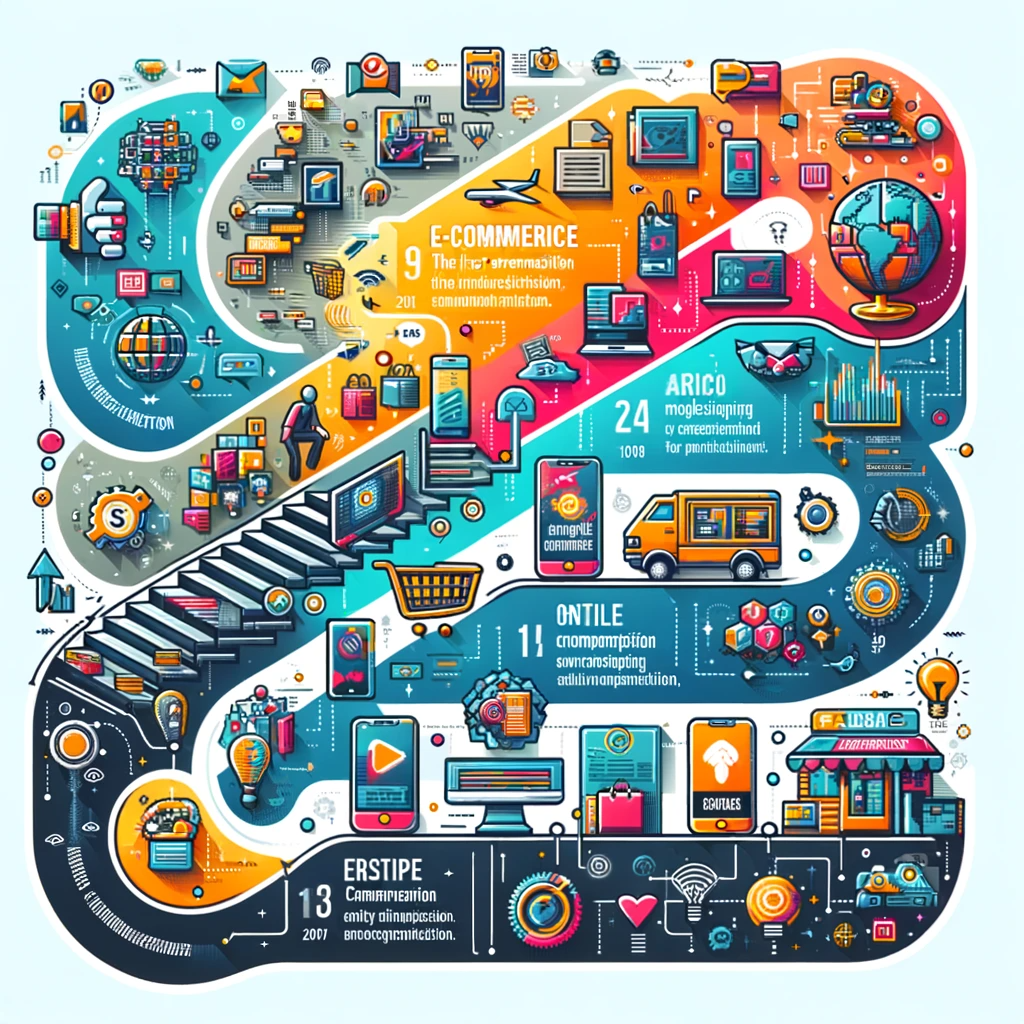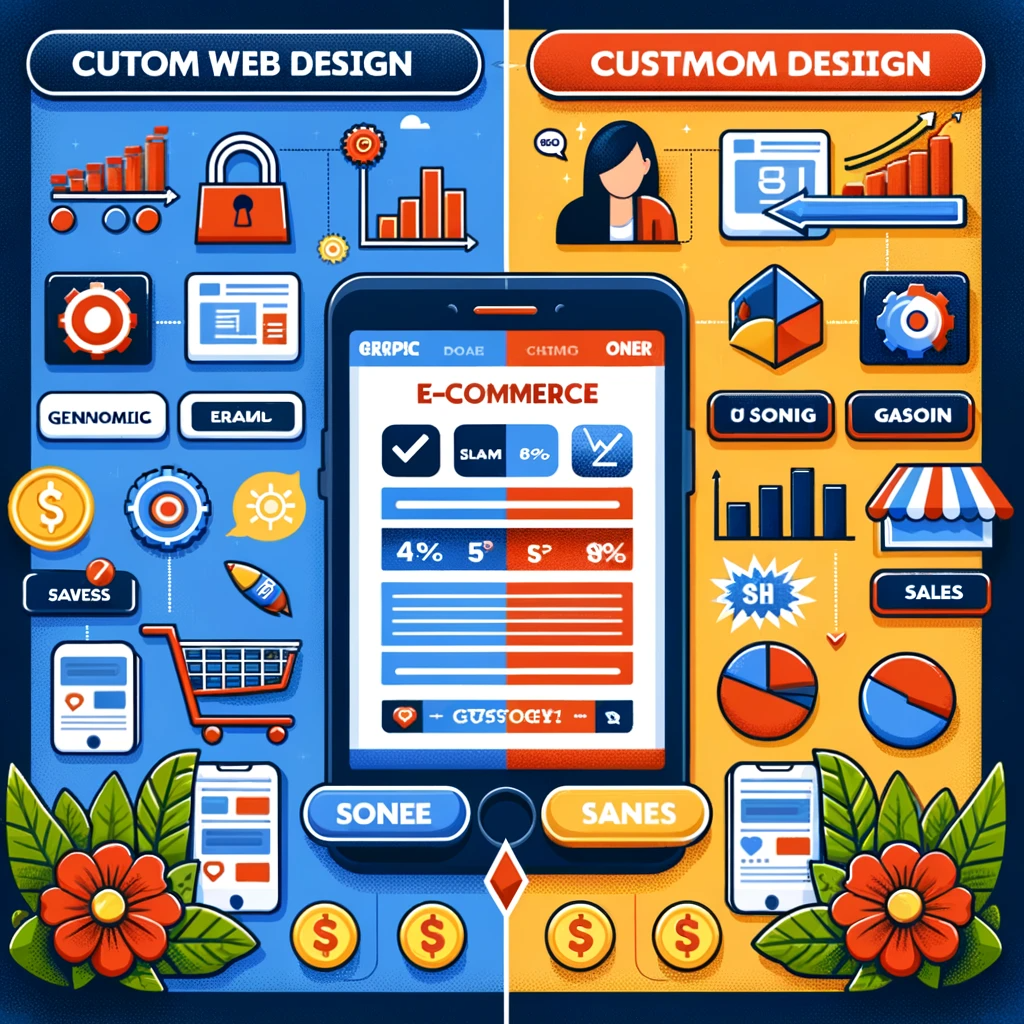In the ever-evolving landscape of online retail, the fusion of e-commerce solutions and custom web design has become a cornerstone for success. As we venture into this exciting realm, it's crucial to understand how these elements work together to create a seamless and effective online shopping experience. This article delves into the intricate relationship between advanced e-commerce functionalities and bespoke web design, highlighting how they revolutionize the way we approach online retail.
From the early days of simple web transactions to today's sophisticated digital marketplaces, e-commerce has undergone a remarkable transformation. Custom web design has been at the forefront of this evolution, continually adapting to meet the changing needs of both businesses and consumers. It's not just about aesthetics; it’s about creating a user-centric experience that resonates with shoppers and drives conversions. In the following sections, we'll explore the critical features of effective e-commerce websites, examine the impact of tailored web designs on e-commerce success, and look ahead to future trends that are set to reshape the online retail landscape.
As we embark on this journey, remember that the intersection of e-commerce solutions and custom web design isn't just about technology; it's about creating a connection with your audience and building a platform that embodies the essence of your brand. Let's uncover the strategies and innovations that make this possible.

The Evolution of E-commerce: A Brief History
The journey of e-commerce is a fascinating tale of innovation, adaptation, and growth. It began in the late 1970s, with the first online transaction marking a pivotal moment in the history of retail. This transaction was the inception of what would become a global phenomenon, altering the landscape of shopping forever.
In the early stages, e-commerce was rudimentary, primarily focused on B2B transactions. The 1990s witnessed the birth of major online retailers, setting the stage for the e-commerce boom. The introduction of secure payment gateways in this era paved the way for consumer trust and widespread adoption.
The early 2000s saw a significant shift with the emergence of mobile commerce. Smartphones became the new storefronts, bringing shopping experiences to the palms of consumers. This period also marked the diversification of e-commerce platforms, offering a variety of niches and specialized markets.
The subsequent years have been characterized by the integration of advanced technologies. Artificial Intelligence (AI), Machine Learning (ML), and Big Data analytics began to play crucial roles in personalizing customer experiences. These technologies allowed for sophisticated recommendation systems, predictive analytics, and enhanced customer service.
Today, e-commerce is an integral part of the global economy, continuously evolving with technological advancements. The future promises even more innovation, with trends like augmented reality (AR), virtual reality (VR), and blockchain reshaping the way we shop online.
As e-commerce continues to evolve, custom web design has remained a critical factor in its success. Tailoring online platforms to meet specific business needs and customer preferences has become a necessity. The next sections will explore how custom web design is revolutionizing e-commerce, enhancing user experiences, and driving business growth.

Key Features of Effective E-commerce Websites
In the realm of online retail, the design and functionality of an e-commerce website can make or break a business. A successful e-commerce site goes beyond just aesthetics; it encompasses several key features that collectively enhance user experience, build trust, and drive conversions. Here are the essential components that every effective e-commerce website should have:
- User-Friendly Design: The foundation of a great e-commerce website is its user-friendliness. This includes an intuitive navigation structure, easy-to-read fonts, and a clean, uncluttered layout. A user-friendly design helps visitors find what they're looking for effortlessly, making their shopping experience enjoyable and hassle-free.
- Mobile Responsiveness: With a significant portion of online shopping done via mobile devices, having a mobile-responsive design is crucial. This means your website should look and function seamlessly on smartphones and tablets, providing a consistent experience across all devices.
- Secure Payment Gateways: Security is a top concern for online shoppers. Integrating reliable and secure payment gateways reassures customers that their financial information is safe. This trust is vital for encouraging repeat business and maintaining a positive reputation.
- High-Quality Product Images and Descriptions: Clear, high-resolution images and detailed descriptions give customers a close-up view of the products. Quality visuals and informative descriptions help in making an informed purchase decision, reducing the likelihood of returns and dissatisfaction.
- Customer Reviews and Testimonials: Incorporating customer reviews and testimonials adds credibility to your products and business. Positive feedback from previous buyers can significantly influence the purchasing decisions of new customers.
- Fast Loading Times: Speed is key in the online world. Websites that load quickly provide a better user experience, keeping potential customers engaged and reducing bounce rates.
- Effective Search and Filter Options: A robust search functionality with various filtering options allows customers to easily sort through products and find exactly what they're looking for, enhancing their shopping experience.
- Clear Call-to-Action (CTA) Buttons: Strategically placed CTA buttons guide visitors through the purchasing process, from adding products to the cart to completing the checkout.
- SEO-Friendly Structure: An SEO-optimized website ranks higher in search engine results, increasing visibility and driving more organic traffic to your site.
- Scalability: As your business grows, your website should be able to scale accordingly. This means being able to handle increased traffic and product listings without compromising performance.
An e-commerce website that embodies these features not only attracts visitors but also converts them into loyal customers. In the next section, we'll delve into the impact of custom web design on e-commerce success, highlighting how personalization can further enhance these key features.

The Impact of Custom Web Design on E-commerce Success
Custom web design plays a pivotal role in the success of an e-commerce platform. Unlike generic templates, a custom-designed website is tailored to meet the specific needs of a business, reflecting its brand identity and speaking directly to its target audience. This section explores how custom web design impacts e-commerce success.
- Brand Identity and First Impressions: Custom web design is a powerful tool for branding. It creates a unique identity for your online store, setting you apart from competitors. First impressions are crucial in the digital world, and a distinctive, professional-looking site can significantly influence customer perception and loyalty.
- Enhanced User Experience (UX): Custom design focuses on creating a user-centric experience. By understanding the target audience's preferences and behaviors, designers can create intuitive navigation, personalized layouts, and interactive elements that resonate with users, leading to increased engagement and sales.
- Optimized for Conversion: Every element of a custom-designed e-commerce site can be optimized for conversions. From the placement of call-to-action buttons to the layout of product pages, custom design ensures that the user's journey towards making a purchase is as smooth and persuasive as possible.
- Scalability and Flexibility: Custom websites offer greater scalability and flexibility compared to off-the-shelf solutions. As your business grows and evolves, your website can adapt to new demands, whether it’s adding new features, integrating with other systems, or expanding the product range.
- Improved Search Engine Optimization (SEO): Custom web designs are often built with SEO in mind. By optimizing site structure, loading speeds, and mobile responsiveness, a custom site is more likely to rank higher in search engine results, driving organic traffic to your store.
- Better Analytics and Insights: With a custom website, you can integrate advanced analytics tools tailored to your specific needs. This allows for more accurate tracking of user behavior, helping you make informed decisions to further optimize the site and improve sales.
- Long-Term Cost Effectiveness: While the initial investment for a custom website might be higher than a templated solution, the long-term benefits often outweigh the costs. A well-designed, scalable, and SEO-optimized site will serve your business effectively for years, reducing the need for frequent overhauls.
In conclusion, the impact of custom web design on e-commerce success cannot be overstated. It not only enhances the visual appeal and functionality of your site but also significantly contributes to business growth and customer satisfaction.

Integrating Advanced E-commerce Solutions
The integration of advanced e-commerce solutions into custom web designs is a game-changer for online retail businesses. These tools not only streamline various aspects of the business but also enhance the customer experience, leading to increased efficiency and sales. Let's explore some of the key e-commerce solutions that can be integrated into custom web designs:
- Customer Relationship Management (CRM) Systems: CRM systems help in managing customer data, tracking interactions, and personalizing the shopping experience. Integration of CRM with your e-commerce site allows for better customer service, targeted marketing, and improved sales strategies.
- Payment Processing Solutions: Offering a variety of secure and convenient payment options is essential for an e-commerce site. Integrating advanced payment gateways that support multiple currencies and payment methods can boost customer confidence and reduce cart abandonment rates.
- Inventory Management Software: Effective inventory management is crucial for e-commerce success. Integrating inventory management software helps in real-time tracking of stock levels, automated reordering, and minimizing overstock or stockouts, ensuring a smooth operation.
- AI Chatbots and Customer Service Tools: AI chatbots can provide instant customer support, answering queries and assisting in the shopping process. Integration of these tools enhances customer engagement and support, leading to a better user experience.
- Analytics Tools: Integrating analytics tools into your e-commerce website allows you to gather valuable insights into customer behavior, website performance, and sales trends. This data is crucial for making informed decisions to optimize your site and marketing strategies.
- Email Marketing and Automation Tools: Automated email marketing tools can be integrated to nurture leads, send targeted campaigns, and keep customers informed about new products, sales, and updates.
- SEO Tools: Incorporating SEO tools helps in optimizing your website content for search engines, improving visibility, and driving organic traffic.
- Social Media Integration: Integrating social media platforms with your e-commerce site can enhance your marketing efforts, drive traffic, and increase sales. It also allows for easy sharing of products and customer engagement.
- Augmented Reality (AR) and Virtual Reality (VR): AR and VR technologies can be integrated to provide immersive product experiences, allowing customers to virtually try products before purchasing, significantly enhancing the shopping experience.
- Security Features: Implementing advanced security features, such as SSL certificates, two-factor authentication, and anti-fraud systems, is vital to protect customer data and build trust.
Incorporating these advanced solutions into a custom web design not only streamlines business operations but also provides a competitive edge in the digital marketplace. As we progress, the next section will explore future trends in e-commerce and web design.

Future Trends in E-commerce and Web Design
As we look ahead, the future of e-commerce and web design is set to be shaped by several innovative trends. These developments promise to further revolutionize the online shopping experience, making it more immersive, secure, and user-friendly. Let's explore some of these emerging trends:
- Augmented Reality (AR) and Virtual Reality (VR): AR and VR technologies are transforming e-commerce by providing interactive and immersive shopping experiences. AR allows customers to virtually try products before purchasing, while VR creates a fully immersive shopping environment, replicating the in-store experience online.
- Blockchain Technology: Blockchain is poised to bring increased security and transparency to e-commerce transactions. By facilitating secure, decentralized transactions, blockchain technology can reduce fraud, enhance trust, and streamline supply chain management.
- Voice Search Optimization: With the rise of smart speakers and voice assistants, voice search is becoming increasingly important. E-commerce sites will need to optimize for voice search to ensure they are easily discoverable through these devices.
- Artificial Intelligence (AI) and Machine Learning (ML): AI and ML continue to advance, offering personalized shopping experiences, predictive analytics for inventory management, and improved customer service through chatbots and AI-driven support systems.
- Sustainable and Ethical Practices: Consumers are becoming more environmentally conscious, driving demand for sustainable and ethical business practices. E-commerce platforms will need to prioritize sustainability in their operations, from eco-friendly packaging to ethical sourcing.
- Internet of Things (IoT): IoT devices are set to play a larger role in e-commerce, with connected devices facilitating automated purchases, personalized marketing, and enhanced customer data collection.
- 5G Technology: The rollout of 5G will significantly impact e-commerce, offering faster load times, enhanced AR/VR experiences, and the ability to handle more complex, interactive website designs.
- Social Commerce: Shopping directly through social media platforms is growing, blending social experiences with e-commerce. This trend is leading to more integrated shopping experiences within social networks.
- Headless Commerce: This architecture separates the front-end design of a website from the back-end e-commerce functionality, allowing for greater flexibility and customization in web design without affecting the e-commerce operations.
- Cybersecurity Enhancements: As e-commerce grows, so does the importance of cybersecurity. Enhanced security measures will be crucial to protect customer data and maintain trust.
These trends indicate a future where e-commerce is not only more technologically advanced but also more aligned with customer values and preferences. Embracing these trends will be key for businesses looking to stay competitive and relevant in the ever-evolving digital
marketplace.
As we've explored in this article, the landscape of e-commerce is continuously shaped and advanced by the integration of innovative solutions and custom web design. The evolution from basic online transactions to sophisticated, user-centric shopping experiences reflects the dynamic nature of this industry. The key features of effective e-commerce websites, including user-friendly design, mobile responsiveness, and secure payment options, lay the foundation for successful online retailing.
Custom web design elevates this foundation, tailoring each aspect to meet specific business needs and customer preferences. The impact is clear: enhanced user experience, increased sales, and a strong brand identity. The integration of advanced e-commerce solutions, from CRM systems to AI chatbots, further streamlines business operations and enriches customer interactions.
Looking ahead, the future trends in e-commerce and web design promise even more exciting developments. Technologies like AR, VR, blockchain, and AI are set to redefine the shopping experience, making it more immersive, secure, and personalized. As we embrace these changes, one thing remains constant: the need for e-commerce platforms to adapt and evolve to meet the ever-changing demands of consumers and the market.
In conclusion, the intersection of e-commerce solutions and custom web design is not just a convergence of technology and creativity; it's a strategic approach to building successful online retail businesses. By staying abreast of technological advancements and consumer trends, businesses can create e-commerce platforms that are not only visually appealing and functional but also deeply resonant with their target audience.
-
What are the key elements of effective e-commerce web design?
The key elements include responsive design, SEO integration, the use of visual elements and branding, and the incorporation of advanced features like AI-driven personalization and chatbots. Each of these elements plays a vital role in enhancing user experience, improving search engine rankings, and ultimately driving sales.
-
How does responsive design impact e-commerce success?
Responsive design ensures that an e-commerce website adapts seamlessly to different devices, providing a consistent and user-friendly experience across smartphones, tablets, and desktops. This not only improves user engagement but also positively affects search engine rankings, leading to higher traffic and conversion rates.
-
Why is SEO important for e-commerce websites?
SEO is crucial for increasing the visibility of an e-commerce website in search engine results, making it easier for potential customers to find your products. By optimizing your site with relevant keywords, ensuring a mobile-friendly design, and improving site speed, you enhance the likelihood of attracting targeted traffic, which is key to driving sales.
